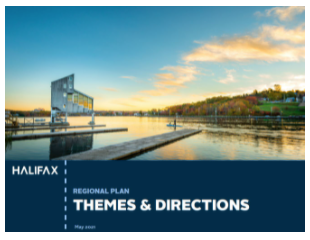This document, the Themes and Directions Report, is the first deliverable of the Regional Plan Review. The purpose of this document is to explain the scope of the Regional Plan Review to the public, stakeholders and Regional Council, and to seek feedback. This document shares ideas about key planning issues and provides details of the work that will be completed during the review. The feedback we receive will help provide focus and direction for future work during the Review.
There will be opportunities for feedback, TBA.
View document as PDF (117 pages)
View by section under Regional Plan Review
———-
Comments from the Backlands Coalition
HRM Planning has released their Themes and Directions document for the current Regional Plan Review. Thanks to Sandy Lake for their leadership in publishing their notice and moving our knowledge forward. Although the document is lengthy, we have tried to simplify your access to relevant parts. If a link we provided does not work, try cutting and pasting the address into your browser.
From the document: The Themes introduce the main overall topic areas. There are 11 themes in total. In the table, each theme is briefly described and explained. If you would like to read the entire theme, there is a link to read the theme in more detail. You may also dive deeper into issue papers that relate to the theme or read further into the background materials that helped to develop the theme.
With this publication, we are now in Phase 2 of public engagement that extends from May 20th until July 2nd. Public consultation will be done virtually to meet public health restrictions. However, the project team will also be identifying alternate ways of outreach and are available to meet with individuals or groups over the engagement period. If you wish to meet with HRM planning, please email them at regionalplan@halifax.ca
If you wish to review the full document document as PDF (117 pages)
The following references relate primarily to the Backlands and may help with your review. You may view the document by themes through this link https://www.shapeyourcityhalifax.ca/regional-plan
Page 19 of Theme 1: Considering the Regional Scale First, section 1.9
RESERVING LANDS FOR LONG TERM GROWTH
The Regional Plan applied the Urban Reserve designation to lands that were identified as potentially suitable for serviced urban development beyond the 25-year horizon of the plan (after 2031). These lands must be studied to determine if they are required for development in the near future and if they are still appropriate places for serviced development. Some lands may no longer be considered appropriate places for serviced development, such as the Shaw Wilderness Park in the Purcell’s Cove Backlands area.
Proposed Action
THE REGIONAL PLAN REVIEW WILL:
1.9 Review the lands designated Urban Reserve where circumstances have changed and make appropriate amendments, such as the Purcell’s Cove Backlands area.
Page 82 & 83 of Theme 7: Integrating Community Facilities and Parks, Wilderness Parks
Shaw Wilderness Park: The Municipality is currently coordinating the development of a Park Management Plan with the Nature Conservancy of Canada, which will include public engagement regarding park stewardship, trail systems and natural asset protection. The park lands will be rezoned “Regional Park” through the Regional Plan Review.
McIntosh Run Regional Park: The Municipality supports the McIntosh Run Watershed Association, who maintain the lands and trail system through a lease agreement. It is anticipated that planning for this park will consider publicly-owned lands in the surrounding area, including the Shaw Wilderness Park, Governor’s Brook District Park, and the Purcell’s Cove Backlands Trail System on abutting crown lands.
In addition to the parks identified above, parks and open spaces with similar attributes that may be under the management of other organizations and levels of government will be incorporated into the framework of regional parks and open spaces in the Regional Plan.
Proposed Actions
THE REGIONAL PLAN REVIEW WILL:
7.6 Incorporate the park spectrum into the Regional Plan
THE REGIONAL PLAN REVIEW WILL:
7.10 Apply the Open Space and Natural Resources Designation and Regional Park Zone to the publicly-owned lands for the Sandy Lake Regional Park, Blue Mountain Birch Cove Lakes Area, Shaw Wilderness Park and McIntosh Run Regional Park, maintain the Western Common Zone for the Western Common Wilderness Common, and adopt policy to guide future park development and management of these areas as “wilderness parks”. Ensure that parks and open spaces owned and/ or managed by community organizations and other levels of government are recognized within this framework.
Theme 8: Enhancing Environmental Protection, Page 86 Green Network Plan Map and Page 88 Planning Tools for Protecting and Conserving Land
Proposed Action
THE REGIONAL PLAN REVIEW WILL:
8.1 Adopt Regional Plan policy requiring that the Green Network Ecology Map is used to help guide regional planning decisions.
Mitigating negative environmental effects of development – Land use by-laws can regulate development so that potential negative impacts on the environment are reduced. This can include requiring the planting or retention of vegetation as buffers, establishing setbacks from watercourses, and regulating the excavation and filling of land to prevent erosion and sedimentation.
Changes to environmental law regarding riparian buffers
Proposed Action
THE REGIONAL PLAN REVIEW WILL:
8.2 Continue to apply the Open Space and Natural Resource designation to recognize the value of the Green Network and revise the designation’s boundaries to reflect the core areas and corridors shown on the Green Network Ecology Map.
8.3 Review Regional Plan policy to ensure that secondary planning strategies and land use by-laws include appropriate development regulations in important ecological areas and corridors and directs development away from hazardous locations.
8.4 Provide guidance for environmental considerations during policy-enabled discretionary planning applications.

